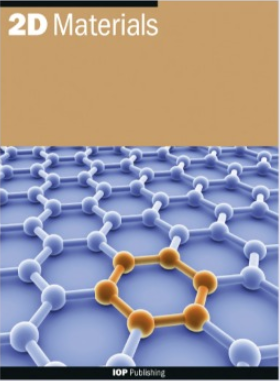二维材料的对称性分类:层组与空间群
IF 4.3
3区 材料科学
Q2 MATERIALS SCIENCE, MULTIDISCIPLINARY
引用次数: 0
摘要
具有三维(3D)晶格的晶体结构的对称性可按 230 种空间群类型之一进行分类。对于某些类型的晶体,如晶体薄膜、表面或平面界面,假设其为二维(2D)晶格更为合适。根据这一假设,晶体结构可按 80 种层组类型之一进行分类。我们采用一种算法来确定具有二维晶格的三维结构的层组类型,并将其应用于计算二维材料数据库(C2DB)中的 15000 多个单层结构。我们比较了单层结构分别按层组和空间群分类的情况。后者是指在垂直于二维晶格的方向上周期性地重复单层(AA-stacking)而得到的三维体结构的空间群。通过这种对应关系,由于空间群无法区分平面内轴和平面外轴,因此有 9 对层群类型被映射为相同的空间群类型。C2DB 中总共有 18% 的单层属于这些层组对之一,因此无法按空间群类型正确分类。我们的研究结果表明,二维材料的对称性分类应以层群而不是常用的空间群为基础。本文章由计算机程序翻译,如有差异,请以英文原文为准。
Symmetry classification of 2D materials: layer groups versus space groups
The symmetry of a crystal structure with a three-dimensional (3D) lattice can be classified by one of the 230 space group types. For some types of crystals, e.g. crystalline films, surfaces, or planar interfaces, it is more appropriate to assume a two-dimensional (2D) lattice. With this assumption the structure can be classified by one of the 80 layer group types. We have implemented an algorithm to determine the layer group type of a 3D structure with a 2D lattice, and applied it to more than 15 000 monolayer structures in the Computational 2D Materials Database (C2DB). We compare the classification of monolayers by layer groups and space groups, respectively. The latter is defined as the space group of the 3D bulk structure obtained by repeating the monolayer periodically in the direction perpendicular to the 2D lattice (AA-stacking). By this correspondence, nine pairs of layer group types are mapped to the same space group type due to the inability of the space group to distinguish the in-plane and out-of-plane axes. In total 18% of the monolayers in the C2DB belong to one of these layer group pairs and are thus not properly classified by the space group type. Our results show that symmetry classification of 2D materials should be based on layer groups rather than the commonly used space groups.
求助全文
通过发布文献求助,成功后即可免费获取论文全文。
去求助
来源期刊

2D Materials
MATERIALS SCIENCE, MULTIDISCIPLINARY-
CiteScore
10.70
自引率
5.50%
发文量
138
审稿时长
1.5 months
期刊介绍:
2D Materials is a multidisciplinary, electronic-only journal devoted to publishing fundamental and applied research of the highest quality and impact covering all aspects of graphene and related two-dimensional materials.
 求助内容:
求助内容: 应助结果提醒方式:
应助结果提醒方式:


